Shredded beef and pepper stir fry features tender juicy beef and crisp peppers cooked with a spicy savory sauce. It’s easy to prepare and has a very bold flavor. Serve it over steamed rice – it’s a perfect weekday dinner that is super appetizing and healthy.
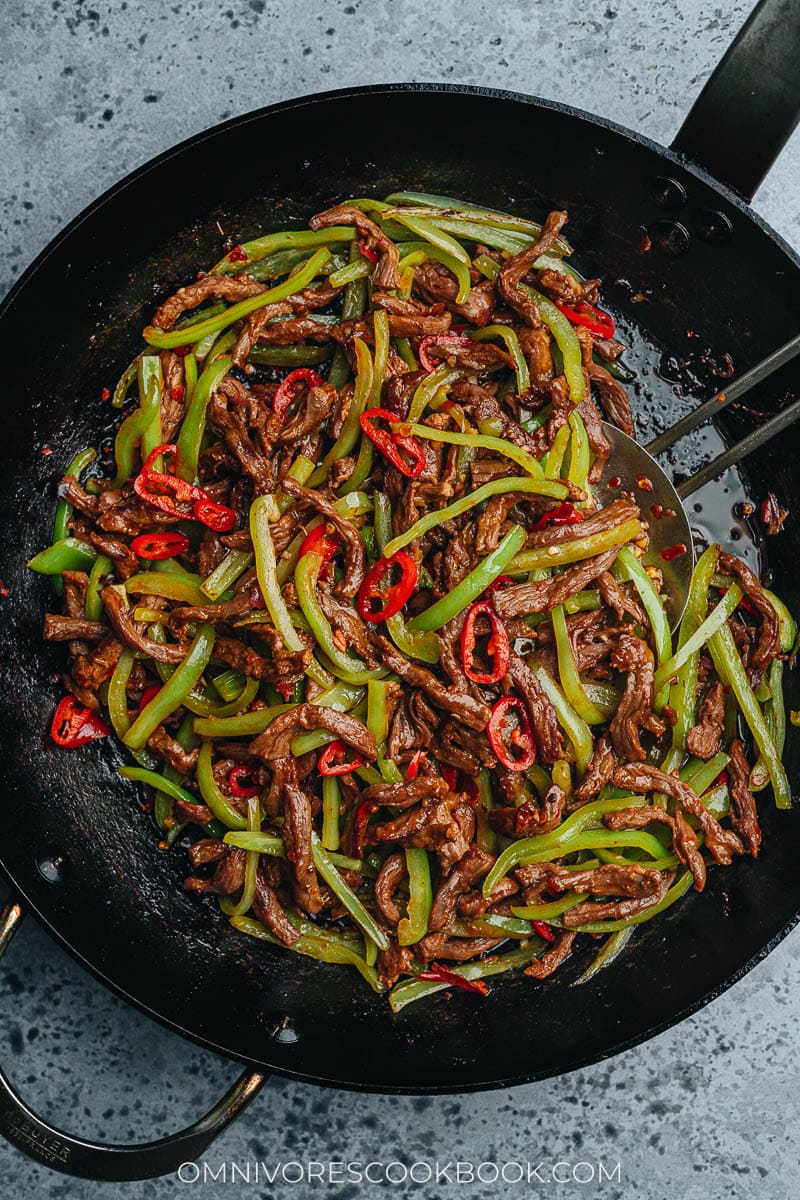
Shredded beef and pepper stir fry, or Qing Jiao Rou Si (青椒肉丝), is a very popular homestyle dish from Sichuan. In fact, it’s so popular that you can easily find it all over China, but its preparation method can be quite different from region to region. Today I want to share the version that I like the most. If you like cooking with chili peppers, you cannot miss this one!
To prepare the beef and pepper stir fry, you will slice the beef and peppers into very thin strips. This way, you will not need much time at all to marinate and cook the ingredients, and the method yields a very flavorful dish. The dish uses just enough sauce to coat the ingredients. But rest assured that the result will be so flavorful that you won’t need extra sauce to soak up with your rice.
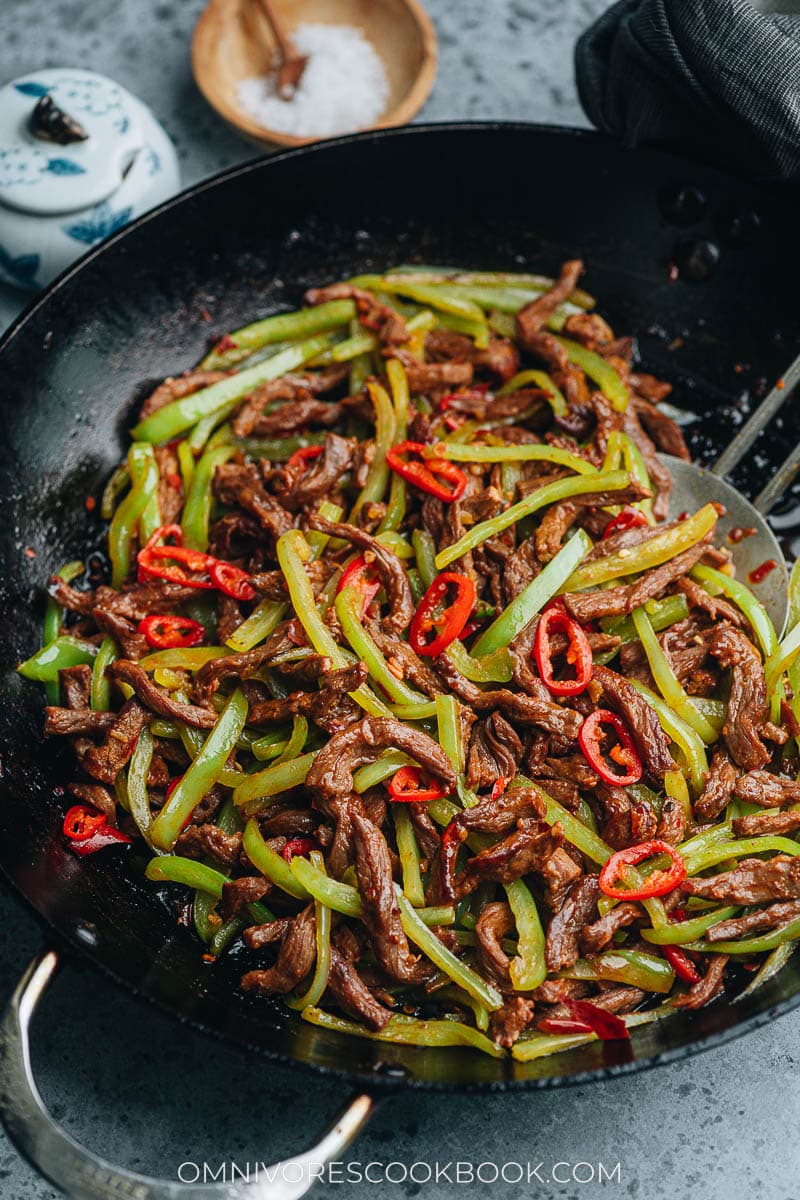
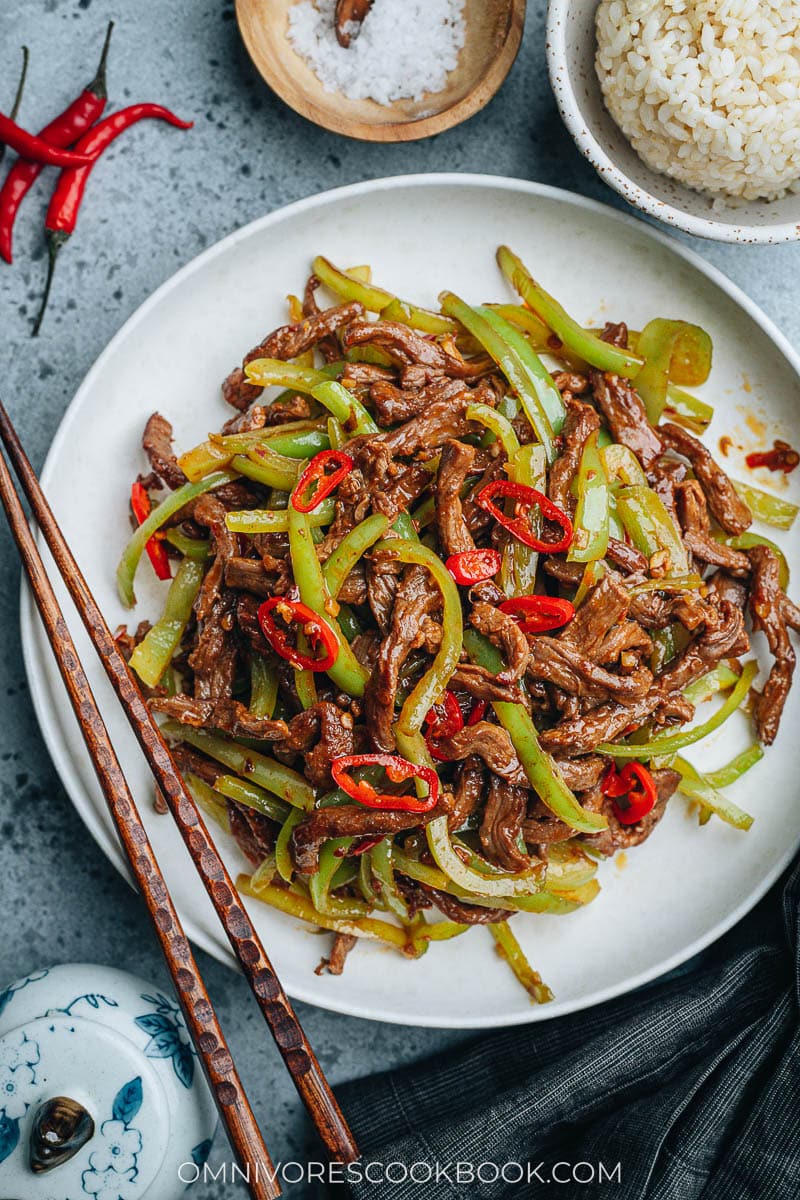
Ingredients for beef and pepper stir fry
What cut of beef to use
My favorite cut for the beef and pepper stir fry is flank steak. However, skirt steak, flat iron and tri tip are some great options as well. If you’re using a tougher cut such as chuck or brisket, you can add a small amount of baking soda into the marinade, which helps tenderize the meat (see recipe below).
What type of pepper to use
In China, both anaheim peppers and long green chili peppers are popular to use in beef and pepper stir fry. The Chinese long green pepper is a bit spicier than the anaheim. Both have a thin, fresh and vibrant flavor, which makes either of them a much better choice than green bell pepper. Living in the US, I found cubanelle peppers have a similar texture and they taste great in this dish.
To add heat and color, a small amount of red pepper is often added to the dish too. I used one long Asian chili pepper. The other options are red jalapeno peppers for medium spicy, or Thai bird’s eye chili peppers for a very spicy result.
Of course, you can use small red sweet peppers or skip this all together for a milder dish. And feel free to experiment with other types of peppers as well.
Doubanjiang
Doubanjiang (豆瓣酱), also known as spicy fermented bean paste or broad bean sauce, is a key ingredient in Sichuan cuisine. It has a strong fermented savory, salty and spicy taste and a small amount goes a long way. It’s an essential ingredient for making authentic mapo tofu.
Although not all beef and pepper stir fry recipes include this ingredient, I really love to use it in my dish. Because it adds so much rich flavor and makes it much more appetizing when served with rice.
Try to find “Pixian Broad Bean Paste” at your Asian market. You can also purchase this brand on Amazon here.
Mise en place
When you’re ready to cook the beef and pepper stir fry, your table should have:
- Marinated beef
- Sliced pepper
- Minced ginger
- Soy sauce
- Sugar
- Salt
For many of my recipes, I prefer to mix the sauce with all the seasonings to simplify the cooking process. But since this recipe only uses a very small amount of sauce, it’s easier to add it more evenly if you separate the ingredients.
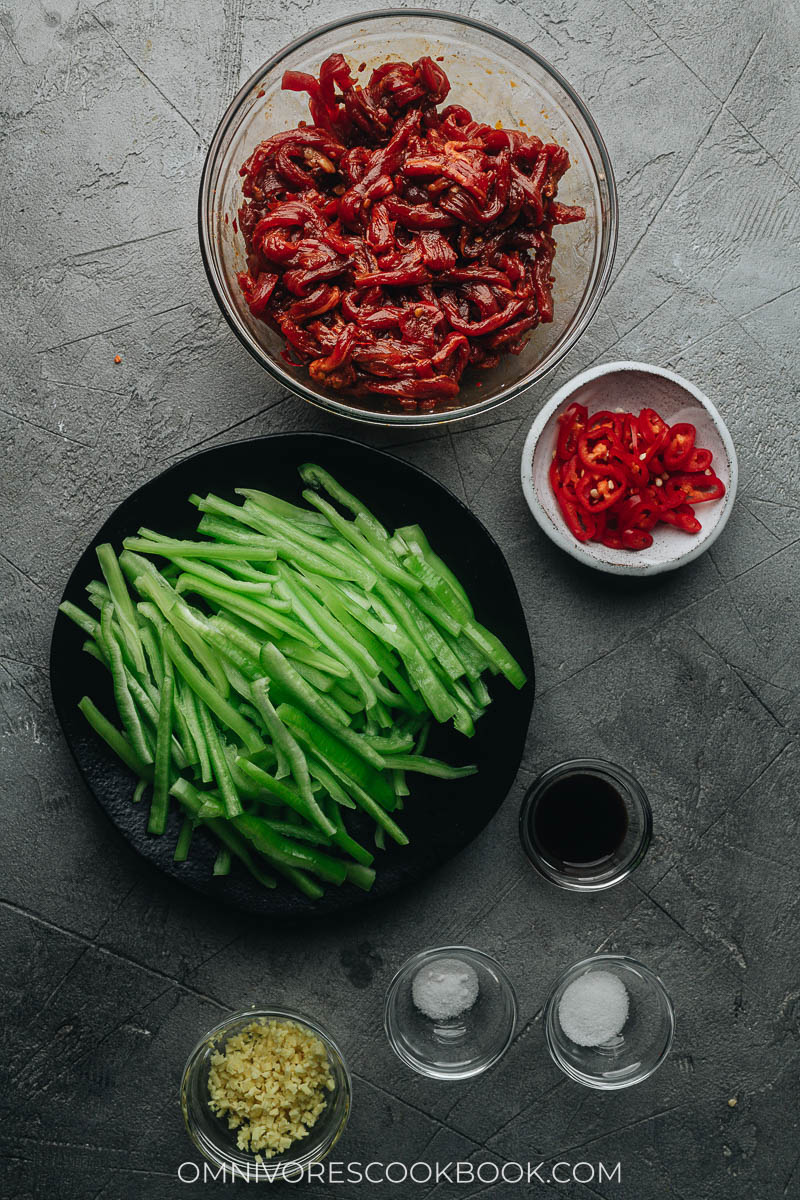
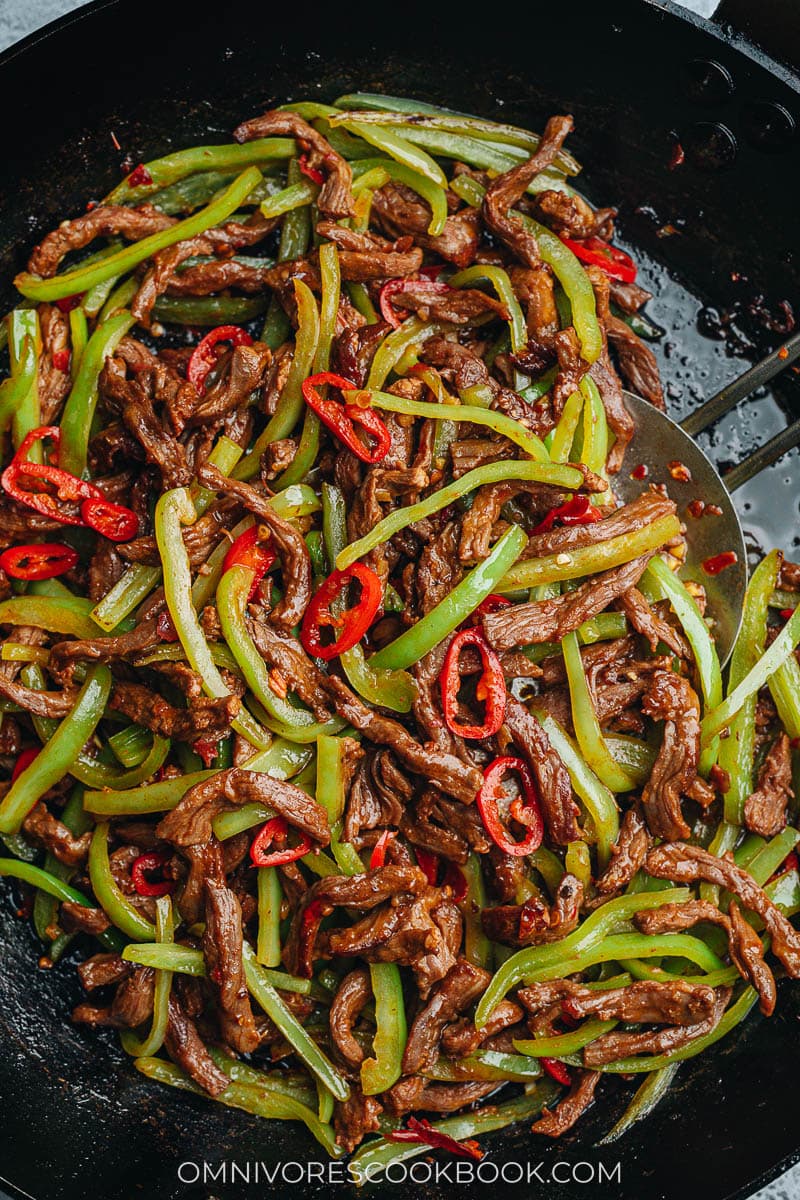
How to prepare beef and pepper stir fry
How to slice the beef
To cook beef and pepper stir fry, it’s important to slice the beef along the grain, so the thin strips won’t fall apart during cooking.
If using flank steak:
- Divide the beef into two pieces, so each is about 2” (5 cm) wide.
- Slice the beef along the grain into thin slices that are about 1/2” (4 mm) thick and 2” (5 cm) long.
- Further slice the beef into strips along the grain, so each is shaped like a matchstick.
I have found that half-thawed steak is the easiest to cut. If you find it hard to slice a fully thawed steak, you can freeze it for 20 to 30 minute before slicing.

Beef and Pepper stir fry cooking process
- Spread out all the beef pieces in a very hot pan
- Cook until the surface is lightly browned, but the inside is still slightly pink
- Cook the ginger to release the fragrance
- Gently stir fry the peppers
- Add back the beef and add the seasonings
- Finish up by adding the hot pepper and stir everything together
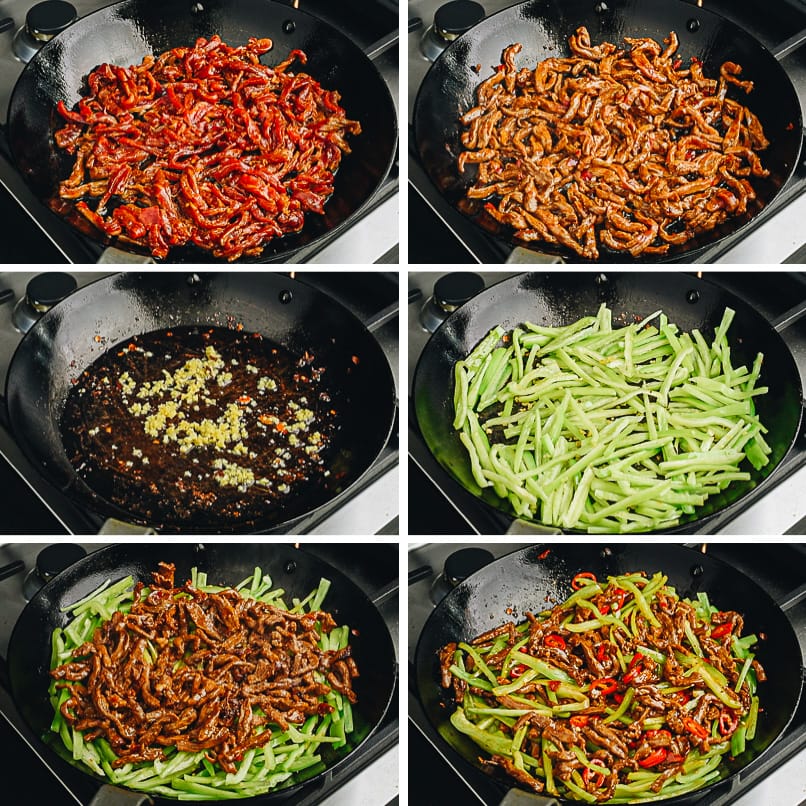
NOTES:
It’s very important to not overcook the beef. The beef is sliced thin and will require very little time to cook. That’s why it’s crucial to use a very hot pan. When the surface of the beef is seared, you should take it out, even if the inside is still a bit pink. The beef will continue to cook when you add it back later.
Twelve ounce (340 g) of beef is the maximum I can cook in my 12.5” carbon steel pan. If you’re using a smaller pan, you should cook the dish in batches so the beef won’t overcrowd the pan.
That’s all! Serve the beef and peppers over steamed rice with egg drop soup for a delicious dinner.
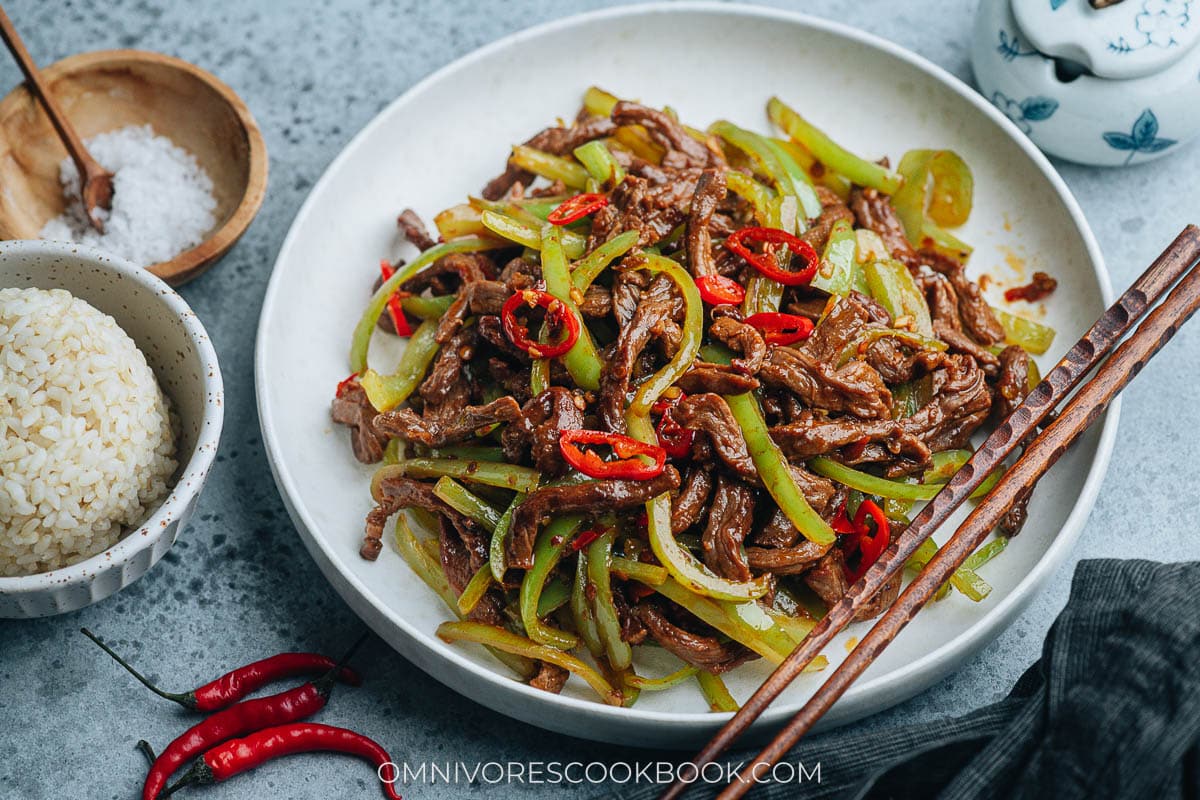
Other easy stir fry dish you might like
- Scallion Beef Stir Fry (葱爆牛肉)
- Garlic Scape Stir Fry with Pork (蒜苔炒肉丝)
- Black Pepper Chicken
- Shredded Pork with Garlic Sauce (鱼香肉丝, Yu Xiang Rou Si)
- Beef and Chinese Broccoli (芥蓝牛肉)

Shredded Beef and Pepper Stir Fry (青椒肉丝)
Ingredients
Marinating
- 12 oz (340 g) beef flank steak (or flat iron, chuck, tri tip) (*Footnote 1)
- 1 tablespoon doubanjiang
- 1/2 teaspoon Shaoxing wine (or dry sherry)
- 1/2 teaspoon dark soy sauce (or soy sauce)
- 1/8 teaspoon white pepper
- 1 teaspoon cornstarch
- 1/4 teaspoon baking soda (Optional, *Footnote 1)
- 2 teaspoons peanut oil (or vegetable oil)
Stir Fry
- 1 1/2 tablespoon peanut oil (or vegetable oil)
- 1 thumb ginger , minced
- 3 (total 8 oz / 225 g) cubanelle peppers , cut into matchsticks (or anaheim peppers)
- 1 long red Asian chili pepper , sliced in rounds (or other type of hot pepper) (Optional)
- 1 teaspoon light soy sauce (or soy sauce)
- 1/2 teaspoon sugar
- 1/4 teaspoon salt
Instructions
- Slice the beef along the grain into thin slices that are about 1/2” (4 mm) thick and 2” (5 cm) long. Then further slice it into strips along the grain. Transfer to a medium-sized bowl. Add the doubanjiang, Shaoxing wine, dark soy sauce, and white pepper. Mix until all the liquid is absorbed. Add the cornstarch and mix well to coat. Then add the oil and mix again. Let marinate while preparing the other ingredients.
- Heat a large skillet over high heat and add 1 tablespoon of oil. When the oil begins to smoke, add the marinated beef and spread it out as much as possible without overlapping. Let sear for 30 seconds without moving, until the bottom is lightly charred. Flip to sear the other sides for 20 seconds. Then stir and cook for another 30 seconds to a minute, until the beef is just browned. Transfer the beef to a large plate, leaving any oil and juices in the pan.
- Pour in the remaining 1/2 tablespoon oil. Add the ginger. Stir a few times to release the fragrance.
- Add the sliced chilis to the pan and stir fry for 30 seconds. Add the cooked beef back to the pan. Swirl in the light soy sauce and sprinkle with sugar and salt. Stir fry for a minute or so, until the seasonings are fully distributed. Immediately transfer everything to a big serving plate so the ingredients won’t keep cooking in the residual heat.
- Serve hot over steamed rice as a main dish.
Notes
- Flank steak is my favorite cut for this dish. However, you can definitely use a cheaper cut if flank steak is not available. If you use any tougher cuts such as chuck or brisket, I highly recommend adding the baking soda, which tenderizes the meat during marinating.














This sounds quite delicious. I love flank steak. It looks beautiful, too.
Delicious and easy! Will be making this again. Next time will add garlic.
Fairly easy and really delicious! Will def make again. Wanted a little more sauce but it didn’t really need it. Great flavor.
Recipe doesn’t state when to add the bell peppers, which is the second most important ingredient. Also, folks need to know that doubanjing is Chinese style chili bean paste. Adding those other fancy chilis don’t add to the final end product plus very hard to get, my opinion – jus use Chinese style hot oil at the end to your likeness of “HEAT”. Also, add sliced onion in addition to bell peppers adds a different flavor to the dish, which I always like to do. I like to resort to this dish, using up left over steaks.